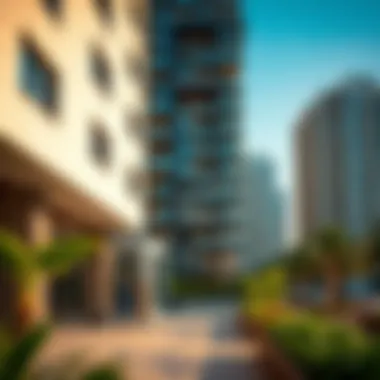Rental Apartments in Dubai: Market Insights and Trends


Intro
Navigating the rental landscape in Dubai can seem like a daunting task, especially with its fast-paced real estate market and myriad of choices. From opulent high-rises in Downtown to quiet developments in Jumeirah Village Circle, each area offers its own unique charm and opportunities. In this article, we aim to paint a detailed picture of what it means to rent an apartment in this bustling metropolis. We'll sift through the pivotal elements that shape the rental market, including trends, sought-after areas, and legal hurdles that potential renters and investors might face.
The essence of this discussion lies in the current dynamics of rental apartments in Dubai, where the blend of luxury and modern convenience meets the demand for livable spaces. This exploration will not only highlight the unique offerings across various neighborhoods but also dissect market conditions that can affect both tenants and investors alike.
Ready to jump in? Let’s roll up our sleeves and dig into the nitty-gritty of rental opportunities available in this vibrant city.
Intro to the Dubai Rental Market
Navigating the Dubai rental market is not just about finding a place to live; it is about understanding a vibrant ecosystem fueled by diverse cultural influences and economic factors. As the city continues to expand, it has become a melting pot for locals, expatriates, and investors alike. Knowing the historical context and current dynamics of the market helps potential tenants and stakeholders make informed choices.
- Importance of Understanding the Market:
- The rental market reflects broader economic conditions.
- Trends in tenant preferences can often be predictors of future developments and investment opportunities.
Rental apartments in Dubai are not one-size-fits-all. Factors like location, community amenities, and even the architecture of buildings can all play a crucial role in decisions made by investors and renters. Recognizing these nuances is key to capitalizing on opportunities or, at the very least, ensuring a comfortable living situation.
Historical Overview
Dubai's rise from a humble fishing village to a global city is a marvel, especially when examining the property rental landscape. In the late 20th century, the emirate started its rapid urbanization journey with the discovery of oil, paving the way for a thriving real estate sector. The real estate boom in the 2000s saw a surge in sky-high constructions and luxury apartments, which currently define the skyline. Significant developments like Burj Khalifa and Dubai Mall not only transformed the city’s face but also influenced the rental markets in those vicinities.
In the aftermath of the 2008 global financial crisis, the market faced a slump. However, recent years have shown resilient recovery, propelled by an influx of expatriates and a renewed interest from investors. The outline of the local laws has also shifted, creating a more transparent landscape conducive to both tenants and landlords. Historical insights provide context to current market behaviors, enriching the knowledge base for those interested in making rental decisions.
Current Market Dynamics
In recent times, the Dubai rental market has shown fluctuating trends shaped by various factors, including economic conditions, supply and demand, and cultural shifts. The market remains highly competitive with a diverse range of options catering to different socioeconomic groups. Currently, places like Dubai Marina, Downtown Dubai, and Jumeirah Beach Residence are in high demand due to their proximity to crucial amenities and lifestyle offerings.
"Real estate in Dubai is not just about bricks and mortar; it's about understanding the fabric of the community."
Here are some of the key components affecting current dynamics:
- Demand Drivers: Economic growth, tourism, and strong infrastructure.
- Supply Trends: New developments have flooded the market, providing more options for renters.
- Rental Price Variations: Rental rates have seen fluctuations based on property type and location, influenced by global market conditions.
The response to the evolving needs of tenants is clear — many new projects are adopting sustainable practices, and properties are increasingly designed with family-friendliness and comfort in mind. As companies and residents become more health-conscious, amenities like green spaces and wellness centers are more sought after than ever. In short, keeping a keen eye on these dynamics can aid in grasping possible future trends, helping both tenants and investors navigate the ever-changing waters of the rental market.
Relevant Resources
- Wikipedia on Dubai
- Britannica Articles on Real Estate
- Reddit Discussion on Dubai Rentals
- Official Dubai Government Information
Understanding the landscape of the Dubai rental market is not only an educational journey but also an essential step towards making sound financial and lifestyle choices.
Key Areas for Rental Apartments
Understanding the key areas for rental apartments in Dubai is pivotal for anyone aiming to navigate this vibrant and sometimes puzzling rental market. Each neighborhood has its unique flavor, advantages, and challenges, making it essential for prospective tenants and investors to identify which area aligns best with their lifestyle and financial goals. From luxurious beachfront properties to bustling urban locales, the array of options available is vast.
Choosing the right location significantly impacts not just rental prices, but also accessibility to amenities, transportation links, and overall quality of life. In a city like Dubai, where the skyline meets the sea, one must consider how different neighborhoods serve various needs—be it a thriving nightlife, family-friendly environment, or proximity to workplaces.
Let’s dissect some of the prime districts where rental opportunities flourish:
Downtown Dubai
Downtown Dubai embodies the spirit of modern urban living. Known for its iconic Burj Khalifa and extravagant shopping experiences at The Dubai Mall, the area is a magnet for both expatriates and locals. Apartments here often command higher rental prices due to their prime location and the lifestyle they offer. However, what you get in return is unparalleled convenience, with restaurants, cultural venues, and entertainment options just a stone’s throw away.
Prospective tenants should be prepared to pay a premium for a space in Downtown Dubai, as living here can often feel like dining in a five-star restaurant every day—spectacular but slightly on the pricey side. Investors, though, often see these high-end rentals as worth every dirham, considering the steady demand and potential for appreciation in property values.


Dubai Marina
Dubai Marina stands out with its stunning waterfront views and a dynamic living atmosphere. The skyscrapers here aren’t just modern marvels; they encapsulate a lifestyle filled with opportunities for leisure and relaxation. Being home to the world’s largest man-made marina, this area is especially popular among young professionals and expatriates seeking an active lifestyle.
Apartments range from cozy studios to lavish penthouses, providing a wide spectrum of choices to cater to different budgets. While rents can escalate during peak seasons, many landlords are willing to negotiate, especially in a competitive market. Renting in Dubai Marina also means enjoying an abundance of cafes, shops, and beaches, enhancing both daily life and investment value.
Jumeirah Beach Residence
For those who dream of life by the sea, Jumeirah Beach Residence, or JBR, is a picture-perfect spot. Here, the turquoise waters are only steps away from an array of dining and shopping options along The Walk at JBR. This area attracts families and beach lovers, making it a prime location for rental apartments.
While the rental prices are generally high due to its beachside location, the opportunity to enjoy seaside living makes it appealing. Families relocating here often appreciate the safe and engaging environment for children, along with the scenic views that are part and parcel of this locality.
Business Bay
Business Bay represents a bustling commercial core, with modern skyscrapers that house firms from across sectors. It is becoming increasingly appealing for tenants who seek rental apartments that blend work and living spaces. The area is well-connected by public transport, making it attractive for professionals commuting to Dubai’s various business hubs.
The rental market here is diverse, attracting not just business professionals but also families who appreciate its rapidly developing amenities. Investors may find promising returns here as the area continues to grow and flourish, thanks to ongoing infrastructural improvements and an expanding population.
Al Barsha
Al Barsha caters to a mix of families and singles alike, often considered a more budget-friendly alternative within Dubai’s rental spectrum. With its community feel, residents enjoy easy access to schools, shopping centers, and parks. Many apartments here offer ample space at relatively lower price points compared to their counterparts.
The variety of apartment types and sizes makes Al Barsha a versatile choice. Notably, it provides residents with a chance to escape the high rents of more central locations while still enjoying a dynamic lifestyle that capitalizes on the charms of suburban living in the city.
In summation, identifying the right area for rental apartments in Dubai requires careful consideration. Each neighborhood has distinct characteristics that cater to different lifestyles and budgets. This awareness can empower both tenants and investors when making choices in this multifaceted market.
Understanding Rental Prices
When it comes to renting an apartment in Dubai, the cost factor looms large, almost like a shadow that follows every prospective tenant and investor. Understanding rental prices isn't just about knowing how much one needs to pay monthly; it encompasses a wide array of elements that drive, shape, and sometimes inflate these costs. Realtors, landlords, and even potential renters must adopt a sharp focus on this topic because it lays the groundwork for any real estate decision-making process. Besides, knowing the ins and outs of rental prices offers a competitive edge in a bustling marketplace.
Insight into Rental Pricing
First off, it’s crucial to grasp that rental prices in Dubai can exhibit significant variation. While one might find a cozy studio in Downtown Dubai for a steeper price, the same quality apartment could be quite a bit cheaper in Al Barsha. A deep dive into understanding these price differences allows individuals to make wise choices about where to live or invest. Breaking down the essentials also unveils the benefits and considerations, such as budgeting appropriately and negotiating better deals.
A Quick Look at Average Rental Costs
A brief glance at average rental costs can highlight how the location profoundly impacts pricing. For instance, an apartment in Dubai Marina might range from 80,000 AED to over 200,000 AED yearly, while a similar space in the suburbs may cost significantly less. Here’s a small overview to keep in mind:
- Downtown Dubai: 100,000 - 250,000 AED annually
- Dubai Marina: 80,000 - 220,000 AED annually
- Business Bay: 75,000 - 175,000 AED annually
- Jumeirah Beach Residence: 90,000 - 300,000 AED annually
- Al Barsha: 50,000 - 150,000 AED annually
Factors Influencing Price Variations
The rental landscape in Dubai features numerous variables that are forever in flux, creating a dynamic environment in which prices can wiggle like a fish on a line. To unearth the reasons behind these variations, consider a handful of crucial factors:
- Location
The proximity to business districts, amenities, and transport links significantly impacts rental prices. Apartments close to schools or healthcare facilities often come at a premium. - Seasonality
There are certain times of the year when the rental market sees more activity, especially around summer and the start of the academic year, leading to potential price spikes as demand increases. - Quality and Amenities
Buildings with swimming pools, gyms, and state-of-the-art security tend to have higher prices. The sheer quality of a property can sway the pricing scale. - Market Sentiment
An unexpected rise or fall in market sentiment can change the playing field overnight, affecting rent prices based on perceived demand. - Economic Conditions
Wider economic factors, such as employment rates and international investment, also play a part. A booming economy often drives rent up, while a downturn can do the opposite.
Comparative Market Analysis
When navigating the intricate tapestry of rental properties in Dubai, performing a comparative market analysis can be a lifesaver. Here’s why it’s essential:
- Evaluate Fair Pricing
By comparing similar properties within the same area, you can properly gauge what a fair rental price looks like. This not only helps in negotiations but also ensures you aren’t paying a premium unnecessarily. - Focus on Trends
An analysis helps reveal underlying trends. For instance, if numerous apartments in a given area are dropping in price, it might hint at changing dynamics and inform decision-making for both renters and investors. - Inform Investment Decisions
Investors can use comparative market analysis to pin down the best opportunities. Identifying which areas are gaining traction can lead to fruitful property investments.
Conducting an Effective Analysis
While conducting your comparative market analysis, a few steps can refine the process:
- List properties that match your criteria in terms of size, quality, and location.
- Review past rental prices to identify trends in increases or decreases.
- Consider enlisting the help of a real estate agent for a comprehensive overview.
Types of Rental Apartments Available
Understanding the types of rental apartments available in Dubai is crucial for both tenants and investors. The vast array of options reflects the city's dynamic real estate landscape, catering to diverse preferences and budgets. This section will delve into the distinct categories of rental apartments, emphasizing their benefits and considerations in a market characterized by growth and competition.


Furnished vs. Unfurnished
When navigating the accommodation options, deciding between furnished and unfurnished apartments is often the first step. Furnished apartments present a convenient choice for those seeking immediate comfort, as they come equipped with essential furniture and appliances. This option is particularly attractive to expatriates or short-term renters, as it spares them the hassle of buying or moving heavy items.
On the flip side, unfurnished apartments offer tenants more flexibility. Renters can personalize these spaces to their unique tastes, which may lead to a more homely feel. Long-term renters may find this option more suitable, as settling into a place without furniture allows for a gradual, more personalized setup. However, potential tenants need to ensure they possess or can acquire necessary furnishings, which might incur additional costs.
Studio Apartments
Studio apartments represent an efficient living arrangement, particularly for single professionals or students in Dubai's fast-paced environment. These compact spaces usually encompass a combined living area, kitchen, and bedroom, making them an economical choice, especially in central areas like Dubai Marina or Downtown.
For investors, studio apartments often reflect strong rental demand due to their affordability and prime locations. The younger demographic, including expatriates and workers relocating to the city, tend to appreciate the practicality of studios, thus offering a remarkable return on investment (ROI). Moreover, they facilitate easy leasing processes, given their attractiveness to a wider audience.
One and Two Bedroom Apartments
One and two-bedroom apartments delve into the realm of greater space and comfort. These options are ideal for small families or roommates, appealing primarily to those who desire privacy while enjoying their shared living experience. The layout typically provides separate bedrooms, a living room, and a kitchen, balancing community and personal space.
In areas like Jumeirah Beach Residence or Al Barsha, one and two-bedroom apartments often come with enhanced amenities, such as pools or gyms, which adds value to the living experience. Investors may find these rentals develop steady demand, particularly in communities attractive to families or working professionals looking to settle down. The relatively higher initial costs can be justified by the potential for increased rental returns due to the demand for larger living spaces within friendly urban settings.
Luxury Rentals
Luxury rentals in Dubai signal the upper echelon of the rental market, characterized by stunning views, high-end finishes, and exceptional amenities. Areas like Business Bay and Palm Jumeirah are renowned for opulent apartments and superb facilities, such as concierge services, private pools, and boutique gym access.
These properties cater mainly to affluent tenants, including expatriates and business executives who seek refined living experiences. The luxury rental market in Dubai has shown resilience, even amidst economic shifts, indicating its attractiveness as a long-term investment. For property owners, maintaining high standards in luxury rentals often results in premium rental prices and lower vacancy rates.
Legal Framework for Renting in Dubai
Understanding the legal framework for renting in Dubai is fundamental for both tenants and landlords alike. This framework lays the groundwork for expectations, rights, and responsibilities, ensuring all parties know where they stand. In a city known for its dynamic rental market, having a grasp of these legalities can prevent disputes and foster a sense of security in rental agreements.
Rental Contracts
Rental contracts in Dubai serve as the backbone of the renting relationship between landlords and tenants. These contracts are typically drafted to comply with the laws established by the Real Estate Regulatory Agency (RERA) and should clearly outline the terms agreed upon by both parties. Important elements to include in the contract are:
- Duration of the tenancy: Are we talking about a short-term arrangement, say six months, or is it a yearly lease? Specifying the duration helps in planning, which is crucial for both parties.
- Rent amount and payment schedule: Clearly stating how much rent is owed and when it should be paid adds transparency. Are payments due weekly, monthly, or annually?
- Deposit requirements: Usually, a security deposit equal to one month’s rent is standard practice, but this can vary, so it should be detailed in the contract.
- Termination clauses: It is necessary to know how either party can terminate the lease, which can save a lot of headaches down the line.
A binding rental contract protects both parties, establishing a clear understanding from the outset. Not only does this help in reducing potential misunderstandings, but it also serves as legal evidence in case disputes arise.
Tenant Rights and Responsibilities
Tenants in Dubai have several rights that are essential to know. These rights include the right to safe and habitable living conditions; this means that landlords must ensure their properties meet minimum standards. Tenants have the right to privacy, as well, allowing them to enjoy their rented space without unwarranted intrusion from the landlord.
However, these rights come with responsibilities as well. For example:
- Timely payment of rent: One of the foremost duties a tenant has is to pay rent on time, as specified in the lease.
- Property care: Maintaining the property in good condition is vital. This includes reporting any damages or issues that might arise. For instance, if a leak occurs, it should be communicated to the landlord right away to avoid further damage.
- Following community rules: Many apartment complexes have rules about noise, common areas usage, and pet policies. Compliance with these regulations helps in maintaining a harmonious environment for everyone.
By understanding these rights and responsibilities, tenants can not only protect themselves but also contribute positively to their living environment.
Landlord Obligations
Landlords in Dubai also have a set of obligations that must be adhered to in the rental agreement. Knowing these can create a more favorable relationship between landlords and tenants. Some key obligations include:
- Maintenance of the property: Landlords must ensure that their rental properties are free from defects and hazards. This means regular upkeep, timely repairs, and ensuring that all utilities are functional.
- Respect for tenant privacy: Without proper notice, landlords should avoid entering a tenant’s rented property. Tenants have the right to privacy, and unwarranted intrusions can lead to disputes.
- Fair treatment: Legally, a landlord cannot discriminate against tenants based on nationality, race, religion, or other personal characteristics. Fair and just treatment should be a given.
Ultimately, landlords are expected to foster a supportive rental atmosphere by meeting their obligations under the law.
It’s crucial for both tenants and landlords to understand their rights and duties to minimize conflict.


Navigating the legal framework for renting in Dubai can seem daunting, but a comprehensive understanding of rental contracts, tenant rights and responsibilities, and landlord obligations can facilitate a smooth rental experience for everyone involved. When both parties are informed, it leads to better communication and reduces the likelihood of disputes.
Rental Process: Steps to Secure an Apartment
Securing a rental apartment in Dubai can oftentimes feel like navigating a jungle—dense, complicated, and full of surprises. The rental process is a pivotal part of the overall experience and knowing the steps involved helps streamline your efforts, reducing potential hiccups along the way. For both tenants and investors alike, understanding this process can determine whether you enjoy a smooth transition into your new home or find yourself grappling with unforeseen challenges.
Initial Research and Viewing
Before setting foot in potential apartments, conducting thorough initial research is crucial. The pouring over multiple listing platforms, browsing through reputable sites like PropertyFinder or Dubizzle, sets the stage for making informed choices. This research gives insight into the market, the neighborhoods, and typical prices.
Some may assume that merely browsing listings suffices, but a savvy approach includes keeping tabs on recent data as trends shift rapidly within the Dubai market. It’s wise to note key factors such as:
- Proximity to public transportation
- Nearby amenities like grocery stores, schools, and parks
- Average rental prices in selected areas
Once your list is more or less compiled, it’s time for viewings. Visiting properties enables you to assess the real deal. Some apartments might sparkle in pictures but turn out to be rather shabby when experienced in person. Be proactive during viewings—ask detailed questions and don’t shy away from inspecting everything from the plumbing to the electronic fittings.
Making an Offer
After narrowing down a compelling selection of options, the next step is making an offer. This phase involves not just stating a price but presenting a compelling case. It's wise to have data on hand regarding comparable rentals to support your proposal. Knowing the numbers can bolster your bargaining power.
Consider including elements in your offer such as:
- Desired move-in date
- Duration of the lease
- Any requests for modifications or repairs
Having a flexible yet firm approach can work wonders. If a landlord knows you are a serious tenant who is making an informed offer, it may curry favor, positioning your proposal ahead of others.
Signing the Lease
The lease signing is the official green light—you're almost home. Pay careful attention during this stage, reviewing each clause meticulously. Rental contracts in Dubai are typically comprehensive and may contain terms regarding:
- Maintenance responsibilities
- Security deposits
- Cancellation policies
It’s essential to clarify any concerns before putting pen to paper. If something looks unclear, it’s better to ask questions than to face potential issues later. Also, make sure to get all agreements in writing—that way, nobody's left holding the bag when the winds of change shift.
Moving In: Checklist
After signing the lease, it’s time to pack your bags. But before you hop on the moving truck, creating a checklist is key to avoiding last-minute scrambles. Consider elements like:
- Setting up utilities (electricity, water, internet)
- Arranging for movers
- Updating your address with banks and other relevant services
- Planning out the layout of furniture in your new space
Additionally, inspect the apartment one last time before moving in. Document any existing damages or issues to avoid disputes over the security deposit later. It’s all too easy to overlook these details in the hustle and bustle of moving day.
"The journey of a thousand miles begins with a single step." - A wise proverb applicable to renting as much as life.
In summary, understanding each phase of the rental process can cushion the blows against unexpected challenges and promote a successful transition into your new home in Dubai. Knowledge is power; leverage it to safeguard your interests and ensure a smooth avenue to your new living space.
Investment Potential in Rental Properties
When looking at Dubai's real estate market, the investment potential in rental properties stands out like a beacon for investors. The city, known for its dynamic economy and ever-evolving skyline, offers various opportunities for astute investors seeking stable and lucrative returns. This section outlines the importance of understanding this investment potential, delving into the elements that make it appealing and the considerations to keep in mind.
Why Investment Potential Matters
The importance of recognizing the investment potential in rental properties lies in the rapidly changing dynamics of Dubai's economy. With a growing population and an influx of expatriates constantly seeking housing, the demand for rental apartments remains robust. This ensures that investors can relish a steady stream of rental income, making property investment a viable option. Additionally, the ever-present opportunities for capital appreciation add another layer of intrigue for investors.
Assessing ROI
Assessing return on investment (ROI) in Dubai’s rental market involves a careful evaluation of various factors:
- Purchase Price vs. Rental Yield: Investors need to consider the initial purchase price of the property in relation to the rental yield. A property in popular areas such as Downtown Dubai or Dubai Marina often commands higher rents but comes with a steep price tag.
- Operational Costs: Beyond rental income, operational costs play a critical role in determining ROI. These can include maintenance fees, property management fees, and even service charges.
- Market Trends: The current state of the market can significantly impact ROI. By analyzing local trends, investors can make informed choices about when to buy and which properties to favor.
Calculating ROI can be straightforward. The formula typically involves subtracting total expenses from rental income and dividing that by the purchase price, presented as a percentage.
ROI = (Rental Income - Expenses) / Property Price * 100



